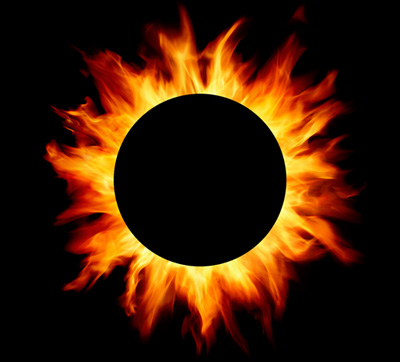
Read our article on the April 8th 2024 Total Solar Eclipse
Find lodges, homes, cabins, and cottages available for the 2023 and 2024 eclipses on our 2024 Eclipse Vacation Homes page. Download the Hill Country Travel App for the most up-to-date eclipse information, maps, videos, total darkness calculations, and more!
There's nothing prettier than the wide-open skies in the Texas Hill Country. For example, if you find yourself a dark and secluded spot at night, you'll see the cloud-like specter of the Milky Way overhead, an intimate view of the billions of neighbors in our home galaxy. Meteors streak by every night, and during certain times of the year showers of them put on a brilliant sky show. The sunrises and sunsets over the picturesque backdrop of the mountains and valleys present a brilliantly-colored start and end to every Hill Country day!
We find ourselves in a unique and astronomically lucky position here in the Hill Country. On Saturday, October 14, 2023, we experienced a stunning annular solar eclipse, where the moon’s relative size left a brilliant “ring of fire” of the sun peeking through as the moon’s shadow crossed the disc of the sun. This was a fairly rare astronomical event; the earth is perfectly positioned in the Solar System for this to happen, but since the moon's diameter is roughly 1/400th that of the sun, it's not often it comes directly between us and the sun to put on such a show. After all, it's like a golf ball blocking out something 54 feet across!
What’s even more rare is the fact that our beautiful Hill Country will be in the “bullseye” of a second solar eclipse, just six months after the annular one! For more information on the full solar eclipse of April 8, 2024, we’d like to direct you to this helpful page of information.
We take the physics and mathematics that accurately predict solar eclipses for granted today, but such wasn't always the case. Back in 2137 BC, the Chinese empire experienced a total solar eclipse. This was a very serious event, for the people needed to be forewarned so they could hit their gongs and shout at the heavens to frighten away the dragons that were trying to devour the precious sun! The royal astronomers at the time, Hsi and Ho, not only failed to predict the eclipse, but they were also so drunk that they slept through it entirely. For these grievous errors, both gentlemen were put to death. Luckily, modern eclipses don't generate such dramatic fallout.
While the annular solar eclipse of 2023 is now in the rear-view mirror, we still have the full solar eclipse of 2024 to look forward to...and it promises to be just as spectacular! Follow this link for the most current information.
Discover the magic of Texas Hill Country with our Facebook Group! Whether you’ve booked a stay with Backroads Reservations, are planning your next getaway, or simply love this scenic region, our community is for you. Connect with fellow fans and celebrate the stunning beauty of the Hill Country!


